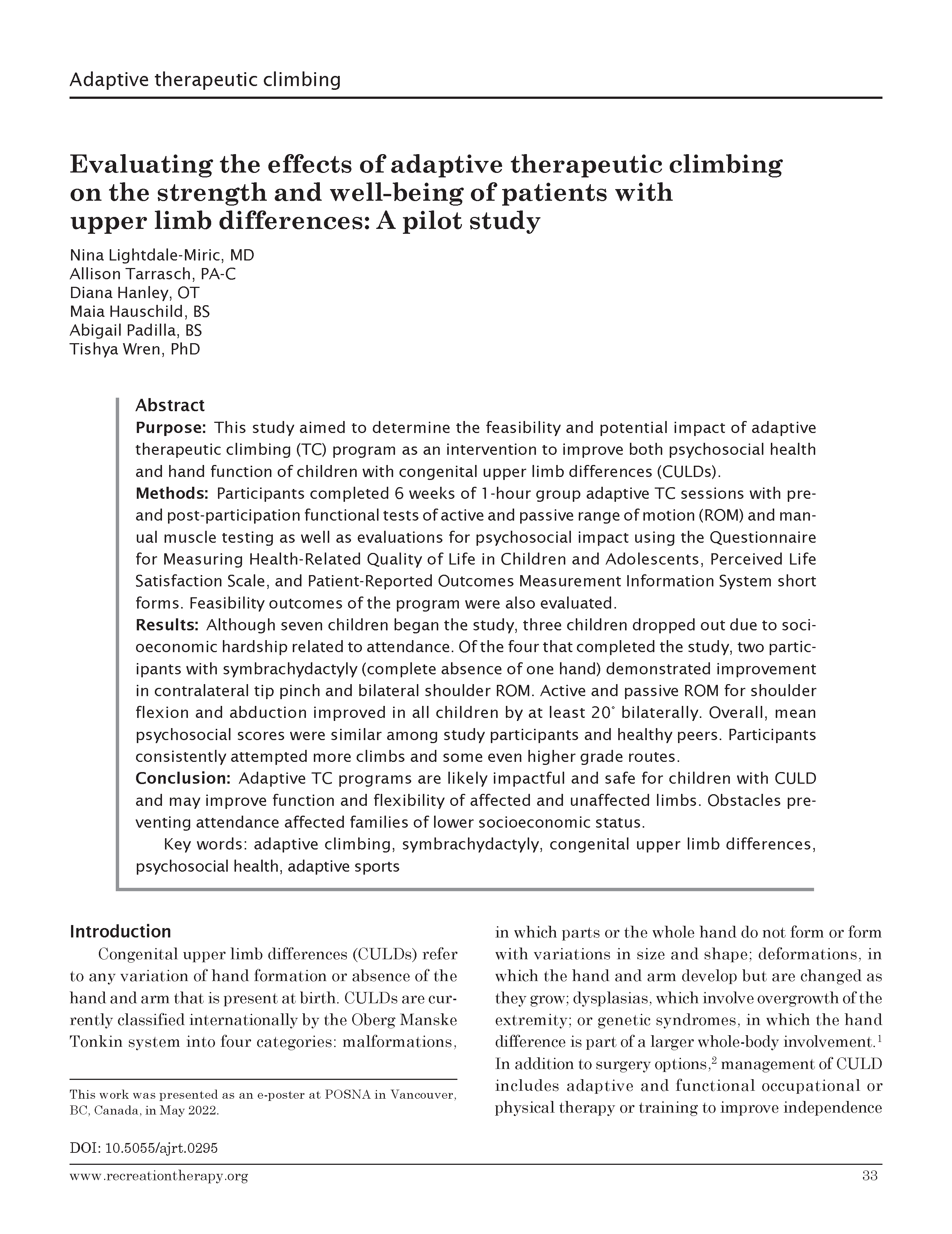Evaluating the effects of adaptive therapeutic climbing on the strength and well-being of patients with upper limb differences: A pilot study
DOI:
https://doi.org/10.5055/ajrt.0295Keywords:
adaptive climbing, symbrachydactyly, congenital upper limb differences, psychosocial health, adaptive sportsAbstract
Purpose: This study aimed to determine the feasibility and potential impact of adaptive therapeutic climbing (TC) program as an intervention to improve both psychosocial health and hand function of children with congenital upper limb differences (CULDs).
Methods: Participants completed 6 weeks of 1-hour group adaptive TC sessions with pre- and post-participation functional tests of active and passive range of motion (ROM) and manual muscle testing as well as evaluations for psychosocial impact using the Questionnaire for Measuring Health-Related Quality of Life in Children and Adolescents, Perceived Life Satisfaction Scale, and Patient-Reported Outcomes Measurement Information System short forms. Feasibility outcomes of the program were also evaluated.
Results: Although seven children began the study, three children dropped out due to socioeconomic hardship related to attendance. Of the four that completed the study, two participants with symbrachydactyly (complete absence of one hand) demonstrated improvement in contralateral tip pinch and bilateral shoulder ROM. Active and passive ROM for shoulder flexion and abduction improved in all children by at least 20° bilaterally. Overall, mean psychosocial scores were similar among study participants and healthy peers. Participants consistently attempted more climbs and some even higher grade routes.
Conclusion: Adaptive TC programs are likely impactful and safe for children with CULD and may improve function and flexibility of affected and unaffected limbs. Obstacles preventing attendance affected families of lower socioeconomic status.
References
American Academy of Orthopaedic Surgeons: OrthoInfo. 2020. Available at https://orthoinfo.aaos.org/en/diseases–conditions/congenital-hand-differences. Accessed June 28, 2023.
Goodell PB, Bauer AS, Oishi S, et al.: Functional assessment of children and adolescents with symbrachydactyly: A unilateral hand malformation. J Bone Joint Surg. 2017; 99(13): 1119-1128. DOI: 10.2106/JBJS.16.01283.
Koskimies E, Lindfors N, Gissler M, et al.: Congenital upper limb deficiencies and associated malformations in Finland: A population-based study. J Hand Surg Am. 2011; 36(6): 1058-1065. DOI: 10.1016/j.jhsa.2011.03.015.
Bavinck JN, Weaver DD: Subclavian artery supply disruption sequence: Hypothesis of a vascular etiology for Poland, Klippel-Feil, and Möbius anomalies. Am J Med Genet. 1986; 23(4): 903-918. DOI: 10.1002/ajmg.1320230405.
Goodell PB, Bauer AS, Sierra FJA, et al.: Symbrachydactyly. Hand (N Y). 2016; 11(3): 262-270. DOI: 10.1177/1558944715614857.
Bae DS, Canizares MF, Miller PE, et al.: Functional impact of congenital hand differences: Early results from the congenital upper limb differences (CoULD) registry. J Hand Surg Am. 2018; 43(4): 321-330. DOI: 10.1016/j.jhsa.2017.10.006.
Ardon MS, Janssen WG, Hovius SE, et al.: Low impact of congenital hand differences on health-related quality of life. Arch Phys Med Rehabil. 2012; 93(2): 351-357. DOI: 10.1016/j.apmr.2011.09.004.
Franzblau LE, Chung KC, Carlozzi N, et al.: Coping with congenital hand differences. Plast Reconstr Surg. 2015; 135(4): 1067-1075. DOI: 10.1097/PRS.0000000000001047.
Côté-Leclerc F, Boileau Duchesne G, Bolduc P, et al.: How does playing adapted sports affect quality of life of people with mobility limitations? Results from a mixed-method sequential explanatory study. Health Qual Life Outcomes. 2017; 15(1): 22. DOI: 10.1186/s12955-017-0597-9.
Diaz R, Miller EK, Kraus E, et al.: Impact of adaptive sports participation on quality of life. Sports Med Arthrosc Rev. 2019; 27(2): 73-82. DOI: 10.1097/JSA.0000000000000242.
Li L, Ru A, Liao T, et al.: Effects of rock climbing exercise on physical fitness among college students: A review article and meta-analysis. Iran J Public Health. 2018; 47(10): 1440-1452.
Varni JW, Setoguchi Y, Rappaport LR, et al.: Psychological adjustment and perceived social support in children with congenital/acquired limb deficiencies. J Behav Med. 1992; 15(1): 31-44. DOI: 10.1007/BF00848376.

Published
How to Cite
Issue
Section
License
Copyright 2000-2025, Weston Medical Publishing, LLC and American Journal of Recreation Therapy. All Rights Reserved.

